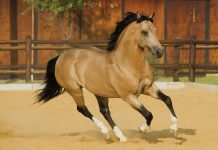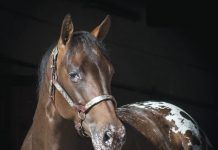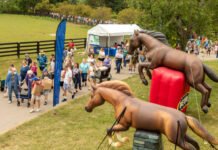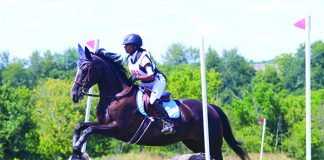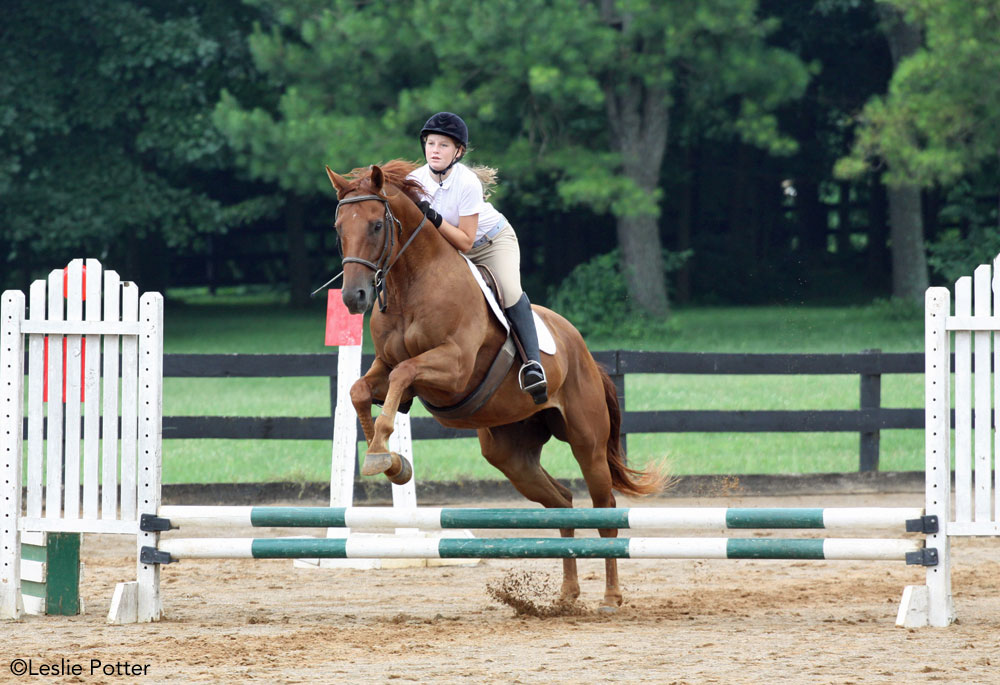
If you love doing dressage and show jumping, look for combined tests taking place in your area. They’re usually organized by barns or local eventing groups. Check out your area’s horsey newsletter or snoop around for show programs at the local tack store.
Combined tests are great because:
They’re a super way to introduce a young horse to eventing. Most combined tests include “greener than grass” divisions that offer an easy intro dressage test and tiny jumps, as well as classes for more experienced eventers like training level or preliminary level with huge jumps.
If you’re an eventer, combined tests are good practice for the three-phase events.
If you don’t get many chances to jump cross-country fences, a combined test is a fun way to test your dressage and show jumping skills.
They’re easier for barns to organize because the manager doesn’t have to build a cross-country course.
They don’t last as long as a three-phase event. There’s not so much hanging around.
They’re usually less expensive to enter than a three-phase event.
Once you’ve found a combined test that you’d like to try, look for the closing date and enter ahead of time. You can’t enter a combined test on the day of the show. You’ll probably have to send a copy of your horse’s Coggins test and a copy of his health certificate along with your entry form.
What gear do you need?
You need the same gear for a combined test that you’d need for a three-phase event.
- A dark showing jacket
- A show shirt with a detachable collar or stock tie
- Beige or light-colored breeches
- Dark helmet
- Boots
- A medical armband for the jumping phase. These armbands with your medical information on them are required at many shows so check to see if the show you’re entering requires one. You can order an armband at www.useventing.com.
- Your horse will use the same gear he would at a three-phase event.
- A snaffle bit for dressage. He can wear a stronger bit for the jumping phase.
- No martingale for dressage, but you can use one in the jumping phase.
- No boots for dressage. You may use them for jumping.
- Saddle and white pad
- Bridle
- Girth
Which division to enter?
Look at the show program and choose a division that suits you and your horse. Pick a division with a jumping height that you’ve been schooling at home. Here are the usual divisions:
Greener than grass: Intro A or B dressage test and cross-rail jumps
Intro: Intro A or B dressage test and small upright fences
Beginner Novice: Beginner Novice eventing dressage tests and 2’7” fences
Novice: Novice eventing dressage tests and 2’ 11” fences
Training: Training eventing dressage tests and 3’ 3” fences
Preliminary: Preliminary eventing dressage tests and 3’ 11” fences
You can get the dressage tests from the United States Eventing Association website. If you have a trainer, she should be able to get them for you.
Dressage time
You’ll be given a dressage time a few days before the show. You may be sent a postcard with your time on it or the time will be posted on a website. Arrive at the show with enough time to collect your number and to warm up properly for your dressage test. Give yourself at least 45 minutes to warm up.
Walk around the warm up area for a few minutes to loosen up your horse and to allow him to get used to the hustle and bustle of the show. Then get to work. Practice the moves you will do in the test. Make sure your horse is listening to you and responding to your aids.
Memorize your test. Most combined tests, like three-phase events, do not allow you to have a “reader.”
There will be a “bit checker” at a combined test so find her when you get to the warm up arena. She makes sure your horse is wearing a snaffle bit. Find out from the ring steward which arena your test will be in and then keep an eye out for the person who’s going before you. When you see her enter the arena, you know that it’s almost time for you to compete.
Stand near the arena when it gets close to your test time. Don’t make the steward hunt for you—this is really annoying for the steward!
When the competitor in front of you halts and salutes, begin working your horse around the arena. When you hear the judge’s bell or whistle, you’ve got one minute to get into the arena, so don’t dilly-dally.
The judge will score your test and your penalties will be tabulated and your score will be posted on a board near the show office. Sometimes this takes a while, so be patient. Remember that the lower your score the better in eventing dressage.
Show jumping
Most shows will announce when the showjumping will begin. It could be right after the dressage or hours later. Keep an eye on the showjumping arena. If you see people walking the course, walk the course, too, because you might not get a chance later.
The courses will be posted outside the arena. Study the course you’ll be jumping and then walk the course. If you’ve got a trainer, he or she will walk the course with you and offer you jumping advice. Think about how many strides your horse will take between fences and note where the start and stop flags are.
When it’s time to tack up, switch bits if necessary and put boots on your horse. Slip on the medical card armband.
Walk up to the warm up area and begin working on the flat. Most warm up areas have one cross-rail fence, one upright and one spread. When you’re warmed up, jump over the cross-rail a few times and then move on to the other fences. Don’t over-jump your horse. Each horse is different, but two times over each fence should be enough for most horses.
Look for the person who went before you in the dressage because she’ll probably jump before you.
When she jumps over the last fence, you should be at the gate. Wait until the steward gives you permission to enter the arena and then walk in. Look at the jumping judge and make sure she’s looking at you and then salute her with a nod. Wait until the starting bell or whistle to begin your course.
Most combined test showjumping courses have a time limit. If you jump too slowly, you’ll be given penalty points. Knocking down a fence or a refusal will earn you four penalty points each. And if you’re doing beginner novice, novice or training level combined tests, three refusals will result in elimination.
After you’ve jumped, take your horse back to the trailer or stall and untack him. Now you’ll have to wait—and wait. It always seems like it takes forever for the scores to be posted! Be patient and don’t bug the show secretary too much. She posts the results as soon as she can.

